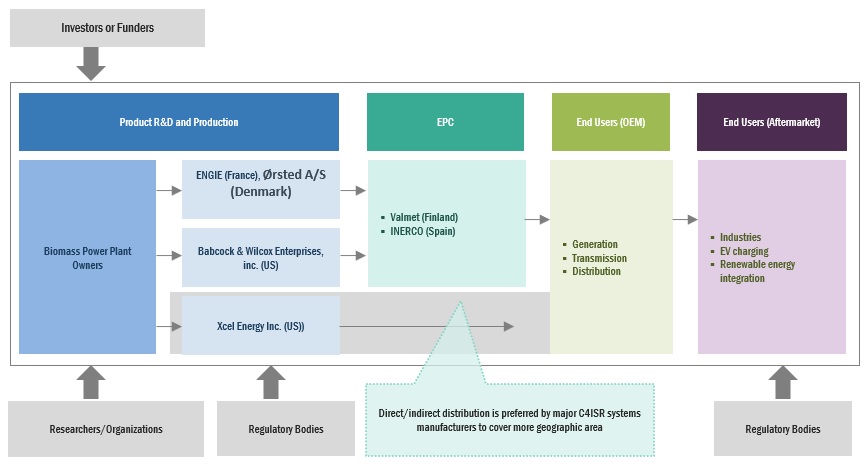The global biomass power generation market is projected to reach USD 105.7 billion by 2028 from an estimated USD 91.3 billion in 2023, at a CAGR of 3.0% during the forecast period. The growth of the biomass power generation market is driven by the focus of governments worldwide on net zero carbon emissions and their related initiatives such as policies, subsidies etc.
Biomass power generation solutions will play a crucial role in reducing carbon footprints. To achieve these, governments are undertaking several initiatives to meet the future demands of energy by promoting the use of renewable sources to produce energy. The abundant availability of feedstock, low labor costs, need for electricity in rural areas and low cost of feedstock are some of the important driving factor of biomass power generation market.
Key Market Players
The biomass power generation market is served by many international players with global operational presence and local players with a strong domestic supply network. ENGIE (France), Xcel Energy Inc. (US), Babcock & Wilcox Enterprises, Inc. (US), EPH (Czechia), and Ørsted A/S (Denmark) are the market leaders in the global biomass power generation market. These companies use strategies such as contracts, agreements, partnerships, acquisitions, and expansions to increase their market share.
Download PDF Brochure – https://www.marketsandmarkets.com/pdfdownloadNew.asp?id=248100990

ENGIE is a global industrial company in low-carbon energy and services businesses. The company operates in energy transition, electric generation, renewable energy, and natural gas fields through seven segments: Supply, Energy Solutions, Thermal, Networks, Renewables, Nuclear, and Others.
The Renewables segment generates wind energy, biomass, biogas, green hydrogen, and hydropower. ENGIE has converted its conventional coal plant into a biomass power plant. This plant, named Max Green Biomass power plant, is located in Rodenhuize, Belgium, and has a biomass capacity of 205 MW. It is one of the largest green electricity generation facilities in Belgium.
ENGIE has a presence in 27 countries in Europe and 48 countries worldwide. Engie has a solid foundation in France and Rest of Europe for renewable energies.
Xcel Energy Inc. is a major US-based electric and natural gas company. The company is majorly involved in wholesale commodity services and trading operations. The company operates through three segments: Electric, Natural Gas, and Other.
The Electric segment generates, transmits, and distributes electricity in Minnesota, Wisconsin, Michigan, North Dakota, South Dakota, Colorado, Texas, and New Mexico. This division also offers resale sales and wholesale transmission services to various entities in the US. The company currently owns four biomass co-firing power plants. The plants use a mixture of biomass, coal, and oil as fuel for power generation. The company also develops biomass conversion technology in collaboration with various companies.
Xcel Energy Inc. operates in eight states and provides a comprehensive portfolio of energy-related products and services.
Energetick a prmyslov holding (EPH) is a leading Central European energy group with assets in the Czech Republic, Slovakia, Germany, Italy, Ireland, the UK, France, and Switzerland. EPH operates through three segments: EPIF Group, EPPE Group, and EPH Others.
EPIF Group is a vertically integrated energy utility that provides services across the whole value chain, including highly efficient cogeneration, power and heat generation, natural gas transmission, gas storage, and distribution and supply of gas, heat, and electricity. Trading and logistics platforms, gas infrastructure management, and real estate development are also included in the scope. EPH has acquired a small-scale power utility that runs on renewable resources such as solar, wind, and biomass.
Request For The Sample Pages – https://www.marketsandmarkets.com/requestsampleNew.asp?id=248100990
This report segments the biomass power generation market based on feedstock into four types: Agriculture Waste, Forest Waste, Animal Waste, and Municipal Waste. Forest Waste are expected to be the fastest market during the forecast period. Forest Waste mainly consists of the woody biomass. The woody biomass has been used traditionally for cooking and heating applications. According to the estimates, more than 55% of biomass comes from forest waste, to which the pulp & paper industry is the largest contributor.
This report segments the biomass power generation market based on technology into four categories: combustion, gasification, anaerobic digestion and pyrolysis. The gasification segment is expected to be the second-largest segment during the forecast period. Gasification is an emerging technology used for the power generation. A large number of projects are upcoming for gasification to produce electricity. For instance, Bio&Watt has one commercial biomass gasification plant for cogeneration on a small scale. The plant utilizes agro-industrial residues in the gasification process.


